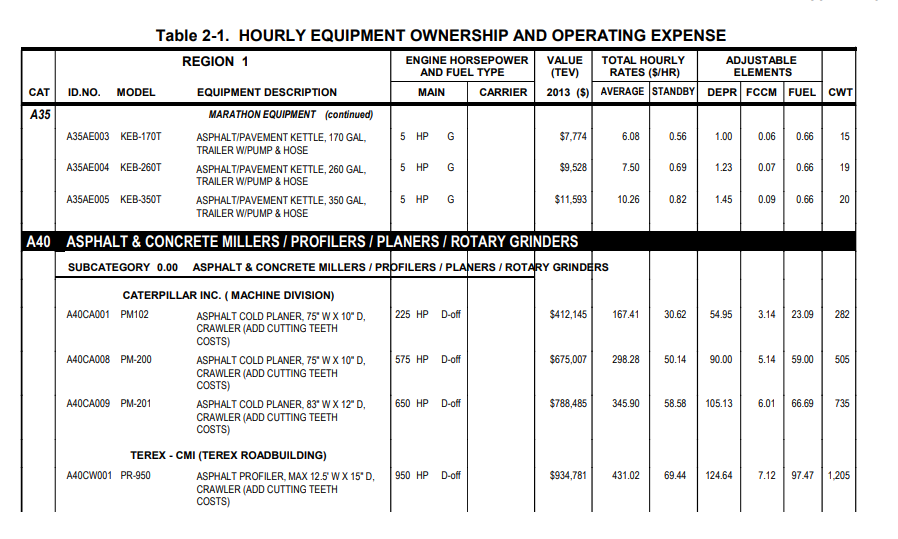US Army Corp of Engineers Equipment Rates are structured in a cost per hour format, where one hour = one hour of active use of that equipment (as opposed to standby use, which only recognizes ownership costs, not operating costs). Furthermore, they are divided into 12 regions, that contain region-specific multipliers, which aim to represent the relative local differences in equipment cost operation. For example, the cost of operating an excavator in Alaska’s cold climate with a more limited operating window, when compared to the American south, is well known.
Compared to other equipment cost per hour solutions, like the Rental Rate Blue Book from EquipmentWatch, the US Army Corps of Engineers Equipment Rates are difficult to access, difficult to interpret and more time consuming to determine.
The home page for their rates are here, although they do not directly link to the database of rates. The following snapshots of rates is from a pdf version of their instruction manual.

See a detail of the US Army Corps of Engineers Rates data, above. One rate is characterized as having:
- A Make and Model, e.g. “Caterpillar PM102”
- A unique ID, e.g. “A40CA001”
- A 3-level taxonomy, e.g. “Asphalt Cold Planer > 74″w x 10″d > Crawler”
- A key specification, e.g “Engine Horspower = 225 HP”
- An original equipment cost, e.g. “412.415”
- Total hourly rate for active/average use, e.g. “167.41” (currency = USD)
- Total hourly rate for standby use, e.g. “30.62” (currency = USD) (note – standby use is ownership costs, only)
- Adjustable element, DEPR (depreciation), e.g. “54.95”
- Adjustable element, FCCM, e.g. “3.14”
- Adjustable element, FUEL, e.g. “23.09”
- CWT, e.g. “282”
How are Corps Rates used?
US Army Corps of Engineers rates exist to reimburse equipment utilization for contractors completing civil construction work for the US Army Corps of Engineers, when there is a force account, extra work or time and materials scenario, not covered by a fixed bid. Let’s dive into how reimbursement amounts are calculated.
My reimbursable amount is quantified using this formula:
Amount = US Army Corps Rate per Unit x Number of Units Worked
Most often, the unit worked is in “hours”. So, an example of a reimburseable amount for a “COMPACTOR, VIBROPLATE, 17.7″ X 22″
PLATE, 4,050 LBS IMPACT ” (one of the their equipment types), that was used for 100 hours, would be:
$244.00 = $2.44 x 100
Note, this assumes no regional, depreciation or other adjustments.
CRITICAL TO KNOW: US Army Corp of Engineers equipment rates DO NOT included the labor costs per hour. That is reimbursed separately.
How do I download US Army Corps of Engineers Rates?
The rates are a tad hard to find. Here’s a link to the most recent rates in pdf format. Note, you need to scroll past quite a few pages of instructions before you see the embedded rates.
How often are US Army Corps of Engineers Rates updated?
The frequency at which the Corps updates their equipment rates is a tad unpredictable, indicating they likely respond to major shifts in technology or contractor engagement.
The current Corps rates are from 2018, but are updated periodically in part. Before that, the last major revision was 2-4 years previous. This is challenging as their rates do not keep up with recent increases in machine costs through the Tier 4 Final initiative, which significantly drove up new machine original equipment costs.
How many workable hours are assumed in the US Army Corps of Engineers Rates?
Their rate standard assumes 40 work hours per week. Extrapolated to a monthly rate, assume they use 160 work hours per month (as opposed to a 176 hours standard in the Rental Rate Blue Book).

Can I use US Army Corps of Engineers rates for Estimation?
You could, but we generally wouldn’t recommend it, at least not without modification. Although their rates do represent a cost per hour that represents a reimbursable rate, it is not without a profit margin built in (practically speaking, a cost per hour without margin built in would lead to legal proceedings). If you use Corps Rates, determine a discount %, e.g. 20%, that you think is realistic to your machine use scenario.
Is there an alternative to US Army Corps of Engineers rates for reimbursement?
Yes. The Rental Rate Blue Book by EquipmentWatch is the generally accepted standard for force account reimbursement by the Federal DOT. In turn, since the 1980’s, they encouraged adoption of the Rental Rate Blue Book among state DOT projects. Their preference is connected to:
- A higher rate of updating (2x per year)
- Significantly more data behind their models, including a proprietary used market valuation platform
- Significantly more asset types
Note, the Rental Rate Blue Book is not a free product and requires an annual, paid subscription.








